Projection markovienne de processus stochastiques
Projection markovienne de processus stochastiques
Projection markovienne de processus stochastiques
You also want an ePaper? Increase the reach of your titles
YUMPU automatically turns print PDFs into web optimized ePapers that Google loves.
tel-00766235, version 1 - 17 Dec 2012<br />
[40, Theorem 7.1, Chapter 4] implies that for any x0 ∈ Rd , if (X,Qt0,x0)<br />
isasolutionofthemartingaleproblemforL,thenthelawofηt = (t,Xt)<br />
un<strong>de</strong>r Qt0,x0 is a solution of the martingale problem for A: in particular<br />
for any f ∈ C∞ 0 (Rd ), γ ∈ C1 ([0,∞) ) and ∀t ≥ t0,<br />
<br />
t<br />
qt0,t(x0,dy)f(y)γ(t) = f(x0)γ(0)+ qt0,s(x0,dy)A(fγ)(s,y)ds.<br />
(2.11)<br />
[40, Theorem 7.1, Chapter 4] implies also that if the law of ηt = (t,Xt)<br />
is a solution of the martingale problem for A then the law of X is also<br />
a solution of the martingale problem for L, namely: uniqueness holds<br />
for the martingale problem associated to the operator L on C ∞ 0 (R d ) if<br />
and only if uniqueness holds for the martingale problem associated to<br />
the martingale problem for A on D 0 . Denote C0([0,∞[×R d ) the set of<br />
continuous functions on [0,∞)×R d and vanishing at infinity. Define,<br />
for t ≥ 0 and h ∈ C0([0,∞[×R d ),<br />
∀(s,x) ∈ [0,∞[×R d , Uth(s,x) = Qs,s+t(h(t+s,.))(x). (2.12)<br />
The properties of Qs,t then imply that (Ut,t ≥ 0) is a family of linear<br />
operators on C0([0,∞[×R d ) satisfying UtUr = Ut+r on C0([0,∞[×R d )<br />
and Uth → h as t ↓ 0 on D 0 . (Ut,t ≥ 0) is thus a contraction semigroup<br />
on C0([0,∞[×R d ) satisfying a continuity property on D 0 :<br />
t0<br />
∀h ∈ D 0 , lim<br />
t↓ǫ Uth(s,s) = Uǫh(s,x). (2.13)<br />
3. We apply [40, Theorem 2.2, Chapter 4] to prove that (Ut,t ≥ 0) is<br />
a strongly continuous contraction on C0([0,∞[×R d ) with infinitesimal<br />
generator given by the closure A of A. First, observe that D 0 is <strong>de</strong>nse<br />
in C0([0,∞[×R d ). The well-posedness of the martingale problem for<br />
A implies that A satisfies the maximum principle. It is thus sufficient<br />
to prove that Im(λ − A) is <strong>de</strong>nse in C0([0,∞[×R d ) for some λ where<br />
Im(λ−A) <strong>de</strong>notes the image of D0 un<strong>de</strong>r (λ−A).<br />
4. Without loss of generality, let us put t0 = 0 in the sequel.<br />
For h ∈ D 0 , the martingale property yields<br />
∀0 ≤ ǫ ≤ t < T, ∀(s,x) ∈ [0,T]×R d ,<br />
Uth(s,x)−Uǫh(s,x) =<br />
32<br />
t<br />
ǫ<br />
UuAh(s,x)du.<br />
(2.14)


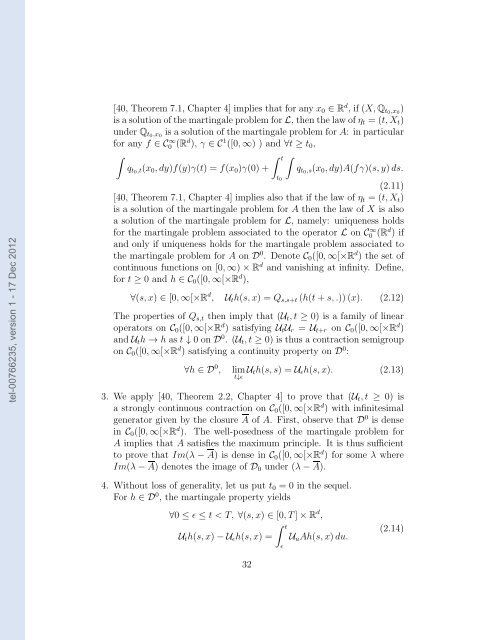

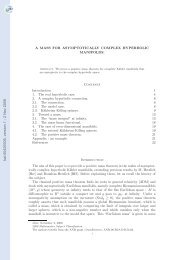
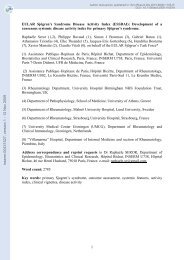
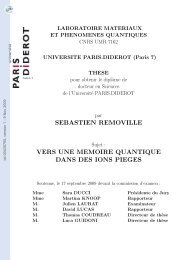
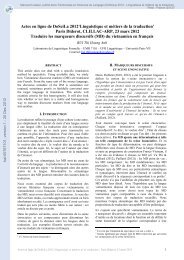
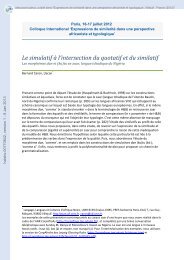
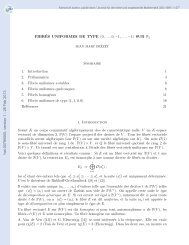
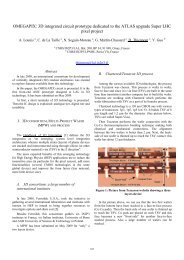
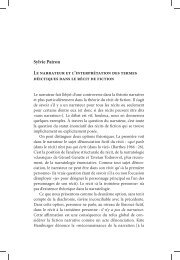
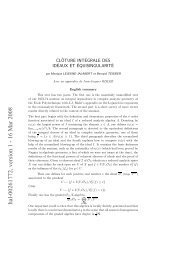
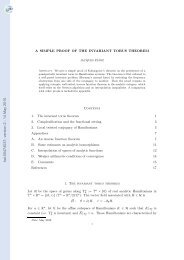
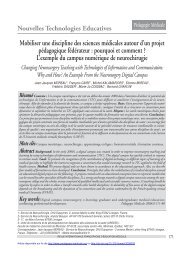

![[tel-00433556, v1] Relation entre Stress Oxydant et Homéostasie ...](https://img.yumpu.com/19233319/1/184x260/tel-00433556-v1-relation-entre-stress-oxydant-et-homeostasie-.jpg?quality=85)